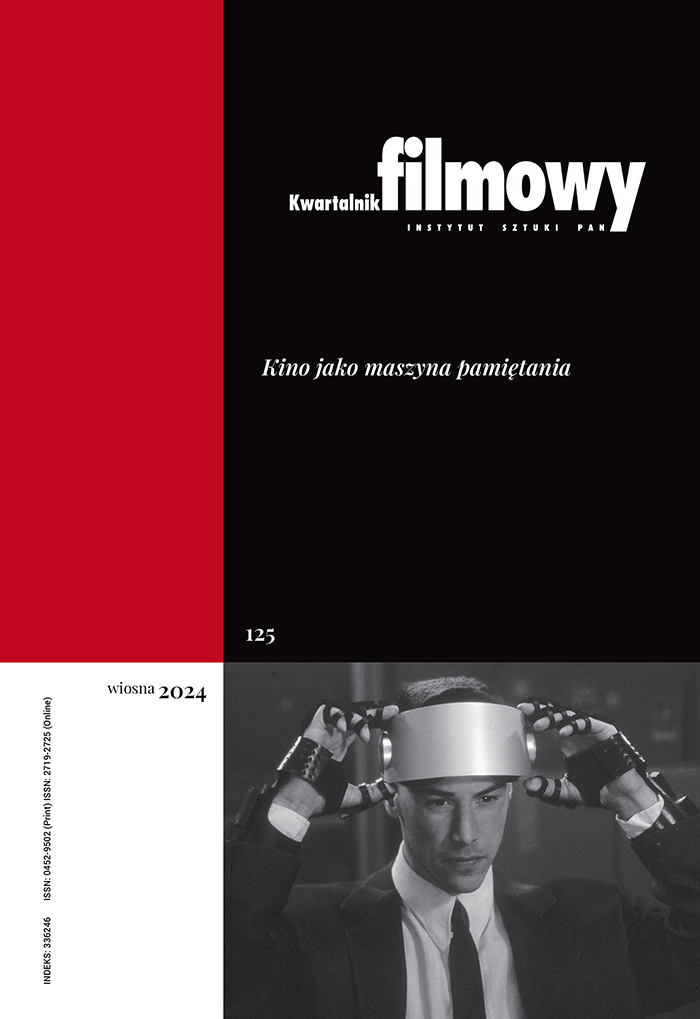The Earrings of Madame De...
Abstract
What fascinated Max Ophüls in Madame de..., a short novel by Louise de Vilmorin, was not so much the storyline, but the construction of the whole story, in particular the axis around which the cycle of events takes place, namely a pair of earrings. Helman tries to show how Ophüls manages this axis in film. A detailed deconstruction of the plot highlights the role the earrings play as an element structuring the film, and their relation with the motif of lies and lying. The earrings function on three levels at the same time: as material objects, as elements of the plot, and on a mental level. The plot is totally fictitious, artificial and constructed, and Ophüls appears to be aiming at some artificial world of film, that does not exist outside of his work. The director plays with he convention of the melodrama, but does not take it seriously. In a similar fashion he enjoys playing with the camera, without celebrating what is achieved with its help. In this manner he achieves an effect of unique, rococo charm, which so far no one could imitate.
Keywords:
Max Ophüls, Louise de Vilmorin, earringsReferences
Armes Roy, French Cinema Since 1946, t. 1, A. Zwemmer Limited, London 1966, s. 55-56.
Google Scholar
Beylie Claude, Max Ophuls, Editions Seghers, Paris 1963, 119-120.
Google Scholar
Ebert Roger, The Earrings of Madame de… http://rogerebert.suntimes.com/apps/pbcs.dll/article?AID=/20011111/REVIEWS08/111110301/1023 (dostęp: 17.06.2011).
Google Scholar
Girard René, Pragnienie „trójkątne”, w: Antologia współczesnej krytyki literackiej we Francji, oprac. W. Karpiński, Czytelnik, Warszawa 1974, s. 347.
Google Scholar
Grost Michael E., The Films of Max Ophuls, http://mikegrost.com/ophuls.htm (dostęp: 17.06.2011).
Google Scholar
http://catchingtheclassics.blogspot.com/2007_05_01_archive.html (dostęp: 17.06.2011).
Google Scholar
Norwich John Julius, Afterwards, w: Madame de, tłum. D. Cooper, Pushkin Press, London 1999.
Google Scholar
Salt Barry, Styl i technologia filmu: Historia i analiza, t. 3. tłum. A. Helman, PWSFTViT, Łódź 2003, 236-247.
Google Scholar
Sarris Andrew, The American Cinema, Dutton, New York 1968.
Google Scholar
Silbergeld Jerome, Dzieci melodramatu, cz. 2, tłum. T. Rutkowska, „Kwartalnik Filmowy” 2005, nr 52, s. 239-242.
Google Scholar
Stewart Henry, The Earings of Madame de…, http://cinepinion.bravehost.com/earrings.html (dostęp: 17.06.2011).
Google Scholar
Vilmorin Louise de, Madame de, tłum. D. Cooper, Pushkin Press, London 1999, 20, 23, 34, 68.
Google Scholar
Authors
Alicja Helmankwartalnik.filmowy@ispan.pl
Jagiellonian University Poland
Historyk i teoretyk filmu, profesor Akademii Humanistyczno-Ekonomicznej w Łodzi, emerytowany profesor Uniwersytetu Jagiellońskiego. Prowadzi badania w zakresie teorii filmu, komparatystyki. W dorobku naukowym ma ponad 20 książek autorskich, m.in.: O dziele filmowym (1970, 1981), Film faktów i film fikcji (1977), Przedmiot i metody filmoznawstwa (1985), Słownik pojęć filmowych (1991-1998), Historia semiotyki filmu, t. 1-2 (1992-1993), Twórcza zdrada. Filmowe adaptacje literatury (1998), Urok zmierzchu. Filmy Luchina Viscontiego (2002), Ten smutek hiszpański. Konteksty twórczości filmowej Carlosa Saury (2005), Odcienie czerwieni. Twórczość Filmowa Zhanga Yimou (2010).
Statistics
Abstract views: 56PDF downloads: 12
License
Copyright (c) 2011 Alicja Helman

This work is licensed under a Creative Commons Attribution 4.0 International License.
The author grants the publisher a royalty-free non-exclusive licence (CC BY 4.0) to use the article in Kwartalnik Filmowy, retains full copyright, and agrees to identify the work as first having been published in Kwartalnik Filmowy should it be published or used again (download licence agreement). The journal is published under the CC BY 4.0 licence. By submitting an article, the author agrees to make it available under this licence.
In issues from 105-106 (2019) to 119 (2022) all articles were published under the CC BY-NC-ND 4.0 licence. During this period the authors granted a royalty-free non-exclusive licence (CC BY-ND 4.0) to use their article in „Kwartalnik Filmowy”, retained full copyright, and agreed to identify the work as first having been published in our journal should it be published or used again.
Most read articles by the same author(s)
- Alicja Helman, Transgressions and Transformations in the Filmmaking of Kornél Mundruczó , Kwartalnik Filmowy: No. 101-102 (2018): European Cinema of 21st Century
- Alicja Helman, Cultural Contexts of Glauber Rocha’s Filmmaking , Kwartalnik Filmowy: No. 103 (2018): Young Polish Cinema – Confrontation of Generations
- Alicja Helman, Difficult Development of Unused Potential , Kwartalnik Filmowy: No. 103 (2018): Young Polish Cinema – Confrontation of Generations
- Alicja Helman, Ideology − Subculture − Breakdance: Tian Zhuangzhuang’s “Rock Kids” , Kwartalnik Filmowy: No. 91 (2015): Film Between Pop Music and Pop Culture
- Alicja Helman, The Paths of Film Studies Development , Kwartalnik Filmowy: No. 85 (2014): Film and Media – the Past and the Future
- Alicja Helman, In Search of Meaning , Kwartalnik Filmowy: No. 87-88 (2014): Film and Theatre
- Alicja Helman, Two Returns , Kwartalnik Filmowy: No. 89-90 (2015): Redefinitions of the Classics
- Alicja Helman, Spider’s Love Game, or on Bernardo Bertolucci’s Adaptation Strategies , Kwartalnik Filmowy: No. 100 (2017): On Celebrating
- Alicja Helman, Not in the Canon, but at the Centre of Matters , Kwartalnik Filmowy: No. 79 (2012): Interiors: On Cinematic Enclosed Space
- Alicja Helman, Early Work of Zhang Yimou and the Art That Inspired It , Kwartalnik Filmowy: No. 65 (2009): Film Image, Image in Film (part II)











